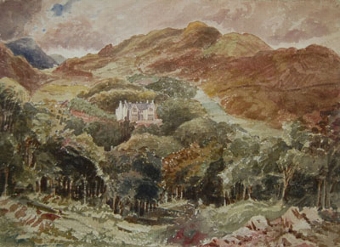featured item

quality pair of antique edwardian postal scales and weights Read more
travellers at knisuvik and sulphur mountains beyond , iceland
- View other items in:
- antiques interior design modern and vintage
- other interior design
artware ltd
Enquire about this antique
Artware Ltd has 565 antiques for sale.
click here to see them all
An account of Sir George Mackenzie''s visit in 1810 to the Sulphur Mountain, which is about three miles distant from Krisuvik. At the foot of the mountain was a small bank, composed chiefly of white clay mixed with sulphur, from all parts of which steam issued. Ascending it, we got upon a ridge immediately above a deep hollow, from which a profusion of vapour arose, and heard a confused noise of boiling and splashing, joined to the roaring of steam excaping from narrow crevices in the rock. This hollow, together with the whole side of the mountain opposite, as far up as we could see, was covered with sulphur and clay, chiefly of a white or yellowish colour. Walking over this soft and steaming surface, we found to be very hazardous, and we were frequently very uneasy when the vapour concealed us from each other.
"The day, however, being dry and and warm, the surface was not so slippery as to occasion much risk of our falling. The danger of the crust of sulphur breaking, or of the clay sinking with us, was great; and we were several times in mminent peril of being scalded. Mr. Bright ran at one time a great hazard, and suffered considerable pain from accidentally plunging one of his legs into the hot clay.
"From whatever spot the sulphur was removed, steam instantly escaped; and in many places, the sulphur was so hot that we could scarcely handle it. From the smell, we perceived that the steam was mixed with a small quantity of sulphuretted hydrogen gas. When the thermometer was sunk a few inches into the clay, it rose generally to within a few degrees of the boiling point. By stepping cautiously, and avoiding every little hole from which steam issued, we soon discovered how far we might venture. Our good fortune, however, ought not to tempt any person to examine this wonderful place, without being provided with two boards, with which every part of the banks may be traversed in perfect safety.
"At the bottom of this hollow, we found a caldron of boiling mud, about fifteen feet in diameter, similar to that on the top of the mountain, which we had seen the evening before; but this boiled with much more vehemence. We went within a few yards of it, the wind happening to be remarkably favourable for our viewing every part of this singular place. The mud was in constant agitation, and often thrown up to the height of six or eight feet. Near this spot was an irregular space, filled with water boiling briskly. At the foot of the hill, is a hollow formed by a bank of clay and sulphur, whence steam rushed with great force and noise from among the loose fragments of rock.
"Further up the mountain, we met with a spring of cold water, a circumstance little expected in a place like this. Ascending still higher, we came to a ridge composed entirely of sulphur and clay, joining two summits of the mountain Here we found a much greater quantity of sulphur than on any other part of the surface, over which we had yet gone. It formed a smooth crust, from a quarter of an inch to several inches in thickness. The crust was beautifully crystallized, and immediately beneath it we found a quantity of loose granular sulphur, which appeared to be collecting and crystallizing, as it was sublimed along with the steam. Sometimes we met with clay of different colours, white, red, and blue, under the crust; but we could not examine this place to any depth, as, the moment the crust was removed, steam issued, and proved extremely annoving. We found several pieces of wood, which were probably the remains of planks that had been formerly used in collecting the sulphur, small crystals of which partially covered them.
"There appeared to be a constant sublimation of this sub stance; and were artificial chambers constructed for the reception and condensation of vapours, much of it might probably be collected. As it is, there is a large quantity on the surface; and, by searching, there is little doubt that great stores may be found. The inconvenience proceeding from the steam issuing on every side, and from the heat, is certainly considerable; but, by proper precautions, neither would be felt so much as to render the collection of the sulphur a matter of any great difficulty. The chief obstacle to working these mines, is their distance from a port whence the produce could be shipped. But there are so many horses in the country, whose original price is trifling, and whose maintenance during summer costs nothing, that the conveyance of sulphur to Reikiavik, presents no difficulties which might not probably be surmounted.
"Below the ridge on the farther side of this great bed of sulphur, we saw a great deal of vapour escaping with much noise. We crossed to the opposite side of the mountain, and found the surface sufficiently firm to admit of walking cautiously upon it. We had now to make our way towards the principal spring, as it is called ; and this was a task of much apparent danger, as the side of the mountain, for the extent of about half a mile, is covered with loose clay, into which our feet sunk at every step. In many places there was a thin crust, below which the clay was wet, and extremely hot. Good fortune attended us; and without any serious inconvenience, we reached the object we had in view. A dense column of steam, mixed with a little water, was forcing its way impetuously through a crevice in the rock, at the head of a narrow valley, or break in the mountain. The violence with which it rushes out is so great, that the noise thus occasioned, may often be heard at the distance of several miles ; and, during night, while lying in our tent at Krisuvik, we more than once listened to it with mingled emotions of awe and astonishment. Behind the column of vapour was a dark-coloured rock, which gave it its full effect.
Antiques.co.uk Ref: 36FE2MNJ
- Materials:
- Watercolour
- Width (cm):
- 22.86 x 15.24 cm 9.00 x 6.00 ins
Artware Ltd
Artware Fine Art specialises in fine antique, decorative and historical portraits and topographical pictures . We cover a period from the 17th and 18th centuries through to the 19th & 20th Centuries. We have over 150 portraits in stock, which can be viewed on our web site, each historical portrait has well researched biographical information both on the sitter and the artist.
Contact details
18 La gare
51 Surrey row
London
Greater London
SE1 0BZ
UNITED KINGDOM
T: 0207 921 97904
E: greg@artwarefineart.com
W: www.artwarefineart.com











